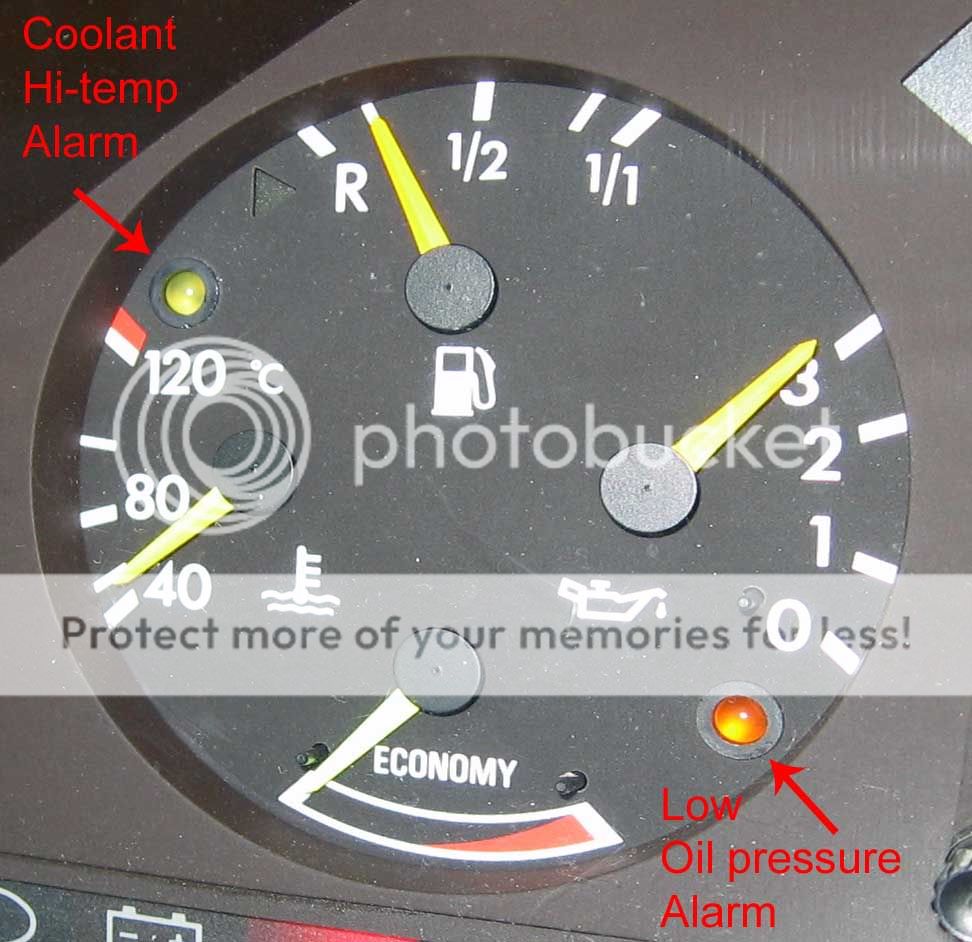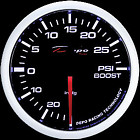 |
 |
 |
 |

|


|
|
|
|
|
|
#1
|
|||
|
|||
|
Vacuum guage installation
I'm guessing this has already been covered many times but not able to find what I want so i am asking.
I am installing a boost guage on my 93 300D, 2.5T. I would also like to put in a separate vacuum guage to monitor my vacuum pump workings (had that fail last year).
Just to be clear, I'll be installing 2 guages, one for manifold boost pressure only and one for measuring the vacuum line pressure (vacuum). Kind of hard to find guages too locally. All they have are the bidirectional vac/boost guages and obviously on the diesel that isn't what I need as those systems are totally unrelated unlike the gasser situation with a turbo. 2nd question.
|
|
#2
|
||||
|
||||
|
0-30" Hg vacuum gauge is perfect for both. Ashtray is perfect location for the gauges. remove the housing (2 phillips) and unplug it.
__________________
85 300D turbo pristine w 157k when purchased 167,870 July 2025 83 300 D turbo 297K runs great. SOLD! 83 240D 4 spd manual- parted out then junked |
|
#3
|
|||
|
|||
|
__________________
there were three HP ratings on the OM616... 1) Not much power 2) Even less power 3) Not nearly enough power!! 240D w/auto Anyone that thinks a 240D is slow drives too fast. 80 240D Naturally Exasperated, 4-Spd 388k DD 150mph spedo 3:58 Diff We are advised to NOT judge ALL Muslims by the actions of a few lunatics, but we are encouraged to judge ALL gun owners by the actions of a few lunatics. Funny how that works |
|
#4
|
||||
|
||||
|
Did you know . .
that "vacuum" and "gauge" are two of the most frequently misspelled words in this forum?
But anyway . . . Almost all vacuum gauges sold into the automotive market in the US of A are 0-30" Hg. The typical MB diesel vacuum pump operates at 20 to 25 inches of mercury so you'll be fine with a 30" gauge. Vacuum gauges aren't much fun to monitor as they never change (unless there's a problem) so you forget to look at them. Another option is to get an gauge cluster from an MB gasser. Swap the left-hand 1/3 (with 4 gauges) for your diesel's left-hand 1/3 (with 3 gauges). The fuel, oil pressure, and temperature gauges, in my experience, use the same meter movements in diesels as they do in gassers. I saw no difference when I installed the gasser gauges in my diesel (does not apply to tach and speedo -- they are definitely different). The fourth gauge is called "Economy" but is simply a vacuum gauge connected to the intake manifold of the gasoline engine. You can connect it to one of lines from your vacuum pump and monitor the pump that way. The cluster in the following picture is actually from a 1984 300SE -- I wanted a panel without the "Unleaded fuel only" markings, see discussion, below.  The "Economy" gauge is not calibrated but you don't really need to know the exact reading, just use the gauge to monitor for unusual changes. If the needle suddenly shifts to a new place, you will know that you have a leak or a problem with the pump. In my car, I have connected the "Economy" gauge to the line that goes to the transmission. If the tranny suddenly develops hard shifts, I should be able to see a change in the vacuum gauge, providing it is a vacuum problem.  This is the finished cluster before I installed it in my '87 300D Turbo. Note that you should get a panel from an early 124 or 126 gasser or the gasoline pump symbol will have an "Unleaded fuel only" note that you will have to paint out. The earlier cars didn't have that note. Note: The red and amber LEDs are warnings for low oil pressure and high coolant temperature that I added. They blink when the oil pressure drops below 15 psi or the coolant temperature rises above 100°C. Jeremy
__________________
"Buster" in the '95 Our all-Diesel family 1996 E300D (W210) . .338,000 miles Wife's car 2005 E320 CDI . . 113,000 miles My car Santa Rosa population 176,762 (2022) Total. . . . . . . . . . . . 627,762 "Oh lord won't you buy me a Mercedes Benz." -- Janis Joplin, October 1, 1970 |
|
#5
|
||||
|
||||
|
Quote:
 And if you use a cheap and readily available switchover valve (solenoid-activated vacuum switch) you can monitor boost in the default and using a momentary switch mounted next to the gauge, switch to vacuum. Checking vacuum is more of a diagnostic and monitoring function so having a separate gauge seems a little overkill. Here's a switchover valve  And most people probably have one sitting around from when they disconnected their EGR. Maybe still under the hood if they used the BB technique. 
__________________
Current Stable
|
|
#6
|
|||
|
|||
|
I did realize I misspelled gauge and have been searching on 'Guage' for 2 days. Turns out it still brings up a fair amount of stuff, I guess others are products of the public school system like me
 . .The full dash panel gauge swap is interesting as is the switchover idea. I think I really like the idea of a dedicated vac gauge anyway as long as I can find a place to mount it. Great ideas that folks have though. Alot of creativity from this community. |
|
#7
|
||||
|
||||
|
Nice work Jeremy.
__________________
83 SD 84 CD |
|
#8
|
|||
|
|||
|
I see some 0-15PSI boost gauges. I was planning on a 0-30, but would a 0-15 be better or likely to max out on my model turbo/car?
|
|
#9
|
||||
|
||||
|
Boost gauges
0-15 psi should be fine. The stock turbo is supposed to max out at 13 psi. 0-30 psi tends to be easier to get but 0-15 will give you better resolution. Try eGauges "Vision" series at this link. The one I put in my '85 (and moved to the '87 when I sold the '85), eGauges #150-101, still works great after 5+ years.
 Some folks have also had success connecting the gasser "Economy" vacuum gauge as a pressure gauge by moving the needle. You get only about 10 psi of range so you have to set it up to measure from 5-15 psi, which is the important part of the range anyway. I think Sixto experimented with that installation. The main advantage is for those people who don't want to sully the looks of their ride with obviously added-on gauges. If you have an artistic bent (not me!) you can relabel the gauge face from "Economy" to "Boost," which I think shows a lot of class. Jeremy
__________________
"Buster" in the '95 Our all-Diesel family 1996 E300D (W210) . .338,000 miles Wife's car 2005 E320 CDI . . 113,000 miles My car Santa Rosa population 176,762 (2022) Total. . . . . . . . . . . . 627,762 "Oh lord won't you buy me a Mercedes Benz." -- Janis Joplin, October 1, 1970 |
|
#10
|
||||
|
||||
|
Documented here - 87 300D gauge cluster innards and boost gauge mod
I only get 7 psi between posts so it's set for 5-12 psi. My eye scans that corner anyway checking the temp gauge. It is an economy gauge since the ALDA's in place. Black = no/low boost = economical, red = boost = not so economical. I have a place to keep change. I've since inked over the 'premium unleaded fuel only' text but I didn't go a good job of it. I only burn premium unleaded Diesel fuel anyway  Sixto 87 300D |
|
#11
|
|||
|
|||
|
Quote:
Thanks Jeremy, exactly the info I need. Not an originalist here, I just want a good reliable guage to look at. I am not sure I can pull off the dash replacement without making a mess  . I also like the price of the VDO guage. Thanks big time. . I also like the price of the VDO guage. Thanks big time.
|
|
#12
|
|||
|
|||
|
That valve is good for 8 psi max.
I use the "economy" gauge as a fuel vacuum gauge so I can tell when a filter is clogging long before it becomes an issue. I noticed this photo was taken about 35k miles ago.
__________________
Greg 2012 S350 BlueTEC 4Matic 2007 ML 320 CDI 2007 Leisure Travel Serenity 2006 Sprinter 432k 2005 E320 CDI 1998 SLK230 (teal) 1998 SLK230 (silver) 1996 E300D 99k, 30k on WVO Previous: 1983 240D, on WVO 1982 300D, on WVO 1983 300CD, on WVO 1986 300SDL 237k, 25k on WVO (Deerslayer) 1991 350SDL 249k, 56k on WVO - Retired to a car spa in Phoenix 1983 380 SEC w/603 diesel, 8k on WVO 1996 E300D 351k, 177k on WVO |
|
#13
|
||||
|
||||
|
Filter clogging
An interesting concept. How is the vacuum gauge "wired" to show filter clogging?
__________________
"Buster" in the '95 Our all-Diesel family 1996 E300D (W210) . .338,000 miles Wife's car 2005 E320 CDI . . 113,000 miles My car Santa Rosa population 176,762 (2022) Total. . . . . . . . . . . . 627,762 "Oh lord won't you buy me a Mercedes Benz." -- Janis Joplin, October 1, 1970 |
|
#14
|
||||
|
||||
|
If it's upstream of the lift pump you can only monitor the small filter. You might need a check valve so you don't get fuel in the cabin when you park nose down with a full tank. Or is there enough air in the line to resist backflow? Are such gauges jittery being so close to the lift pump?
Sixto 87 300D |
|
#15
|
|||
|
|||
|
Quote:
Original diesel fuel flow: tank > inline filter > fuel heater > lift pump > diesel filter > injection pump. Modified diesel fuel flow: tank > inline filter > fuel heater > diesel filter > fuel selector valve > lift pump > injection pump. VO flow: tank > short heat exchanger > flat plate heat exchanger > heated fuel filter > hose in hose fuel line > fuel selector valve > lift pump > injection pump. There is a "T" in the fuel line between the selector valve and the lift pump. The vacuum line goes from that "T" to the gauge. Since the line terminates at that gauge, no fuel can flow up the line because there is no place for the air to go to get out of it's way. With unrestricted filters the needle is barely off the peg. On a long road trip I get several hundred miles notice that the filter needs to be changed. I can then change it at a place and time that is more convenient to me rather than spending "store bought fuel" while I look for a safe place to do it. The needle not jittery at all. A write up of the conversion is here: 1991 350 SDL Conversion to WVO
__________________
Greg 2012 S350 BlueTEC 4Matic 2007 ML 320 CDI 2007 Leisure Travel Serenity 2006 Sprinter 432k 2005 E320 CDI 1998 SLK230 (teal) 1998 SLK230 (silver) 1996 E300D 99k, 30k on WVO Previous: 1983 240D, on WVO 1982 300D, on WVO 1983 300CD, on WVO 1986 300SDL 237k, 25k on WVO (Deerslayer) 1991 350SDL 249k, 56k on WVO - Retired to a car spa in Phoenix 1983 380 SEC w/603 diesel, 8k on WVO 1996 E300D 351k, 177k on WVO |
 |
| Bookmarks |
|
|